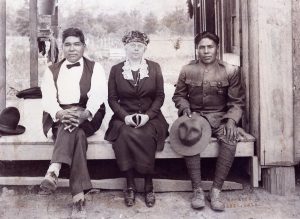School is getting back under way and maybe you realize you need another lesson or two for this week. Because we have subscribers who are both middle school and elementary teachers, and some who teach at schools that are K-8, each week I’ll include a lesson, or maybe a whole unit, for middle school and another for elementary school. Also, middle school teachers may want to consider the elementary lesson for students who are not at grade level – this week’s is on multiplication. Elementary teachers can consider the middle school lesson for advanced students.
Oh, and don’t miss out on free graduate or undergraduate credit making games. Free PD !
You can see the playlist for our first session on co-designing games about Indigenous and rural history here.
Learn more and sign up for the next workshop to be held at Standing Rock here. Travel reimbursement available for teachers in North or South Dakota and surrounding states.
Middle School: Joseph Oklahombi – Cross-curricular lesson on Native American veterans

How can you not love a lesson that combines history and P.E. ? Perhaps you are teaching about U.S. history – World War I or voting rights – and you would like to go beyond the textbook. Maybe your unit on ratio and proportion could use a real-life example. This cross-curricular lesson includes history, mathematics, English language arts, computer applications and physical education. Students play a game which teaches about Native American veterans in World War I. Students are given a presentation on the accomplishments of veteran, Joseph Oklahombi and other Native Americans during WW I. In P.E. class, students sprint 210 yards to simulate Oklahombi’s attack. They are assigned to create a presentation to nominate Oklahombi for the Congressional Medal of Honor. This may include Google Slides, PowerPoint or video presentations.
Elementary School Lessons: Single Digit Multiplication
Our single-digit multiplication series is for Grade 3. The lesson plans with PDF links for printing and Google slide presentations are provided. While it may be tempting to do all lessons in one week, we have found it works better to spread this over a two-to three-week unit.
- Students use visual drawings, manipulatives, and a number line to learn multiplication of one-digit numbers, coupled with their verbal explanations.
- Students will create number sentences independently and with a partner.
- Learning and memorizing multiplication patterns will improve later understanding of division.
- Determine the unknown whole number in a multiplication equation relating three whole numbers.
- Optional Brain Power activities have students write their own word problems.
- Students play games that reinforce memory and apply multiplication in word problems.

Start here with multiplying numbers from 0 to 5.
Follow up with these lessons on multiplying numbers from 6- 9
